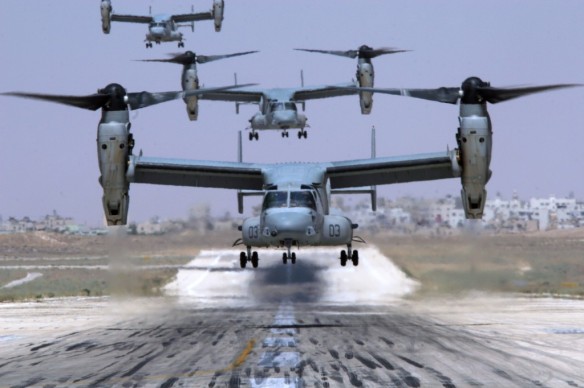
The Osprey is the world’s first tiltrotor warplane. It features the versatility of a helicopter and the speed of a conventional aircraft.
Military planners have long recognized that helicopters, with their relatively slow forward speed and high operating costs, are unsuited for certain types of combat missions. Bell began addressing the problem as early as 1958, when it fielded the XV3, a twin-engine tiltrotor prototype. This combined the vertical takeoff and landing characteristics of a helicopter with the flying abilities of an airplane.
Since that time, advances in technology have allowed great strides in performance and survivability under combat conditions. Successive designs enhanced the practical application of tiltrotor technology, and in 1983 the Pentagon awarded Bell a contract to construct and test two prototypes of its new V22. The Osprey is a medium-sized aircraft with a capacity to carry 24 fully armed troops anywhere in the world. It is constructed almost completely of high-strength, lightweight composites of graphite and epoxy. Amazingly, metal accounts for only 1,000 pounds of the aircraft’s basic structure. Its most dramatic feature is the long, swept-forward wing, whose wingtip engine pods can tilt up or down 90 degrees. This enables the V22 to operate like a helicopter, that is, without the use of runways, yet fly rapidly to its destination. Furthermore, it is completely automated and employs advanced fly-by-wire computers, which render this complex and sophisticated aircraft easy to fly and control in all flight modes.
Bell successfully tested five prototypes commencing in 1987 while politicians dithered over whether to construct the radical craft or not. In 1997 the U.S. Congress finally authorized procurement of 552 Ospreys for the Marine Corps as troop-carrying assault ships. Deliveries began in 1998, and within a few years the V22 will completely replace the slower, more vulnerable CH46 Sea Knight and CH53 Sea Stallion helicopters.
Type: Transport
Dimensions: rotor span, 38 feet; length, 56 feet, 10 inches; height, 17 feet, 4 inches
Weights: empty, 31,772 pounds; gross; 55,000 pounds
Power plant: 2 × 6,150–horsepower Allison T406 turboprop engines
Performance: maximum speed, 315 miles per hour; ceiling, 30,000 feet; maximum range, 2,417 miles
Armament: 2 × .50–caliber machine guns
Service dates: 1998–